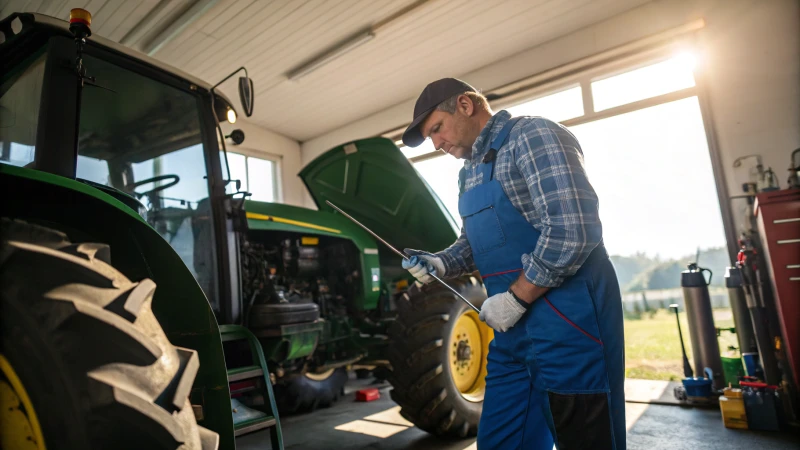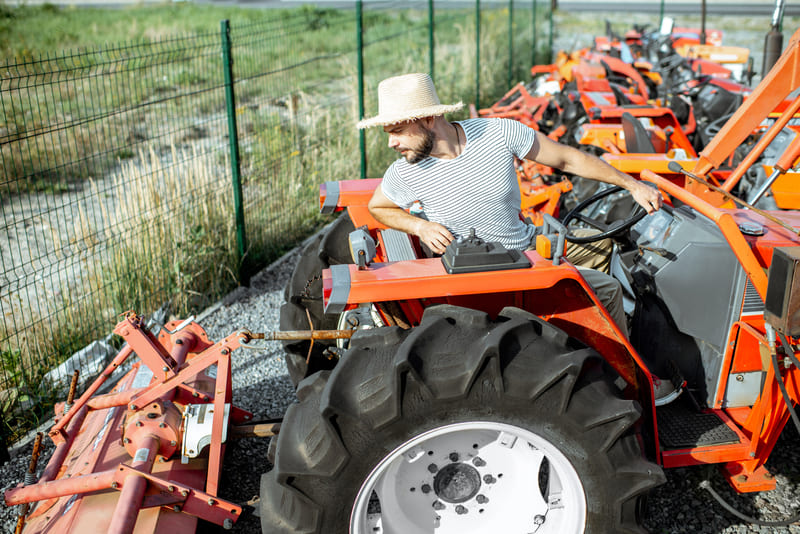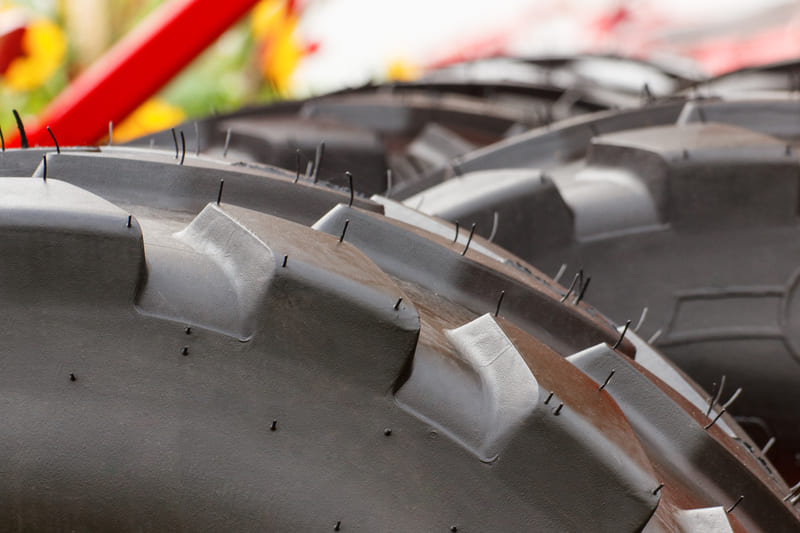Every farmer knows that a well-maintained tractor is the backbone of a thriving farm. Neglecting its care can lead to headaches and unexpected expenses.
Daily tractor maintenance includes checking fluid levels, conducting visual inspections, performing safety checks, examining engine components, and ensuring tire health.
I remember the first time I faced a breakdown during harvest season; it was a wake-up call. Ever since, I've made it a habit to dive deep into each maintenance step. Checking fluid levels is like giving your tractor its morning coffee—essential for kickstarting the day. A quick visual inspection can save hours of repair time by catching minor issues before they snowball. Safety checks ensure that every ride is smooth and secure. As for the engine, a thorough examination keeps it purring like a content cat. Finally, keeping tires in top shape ensures every turn on the field is steady and reliable. With these routines, my tractor runs like a charm, ready to tackle whatever the day brings.
Checking fluid levels daily prevents engine damage.True
Regular fluid checks ensure engine components are lubricated and cool.
Visual inspections are unnecessary for tractor maintenance.False
Visual inspections help identify wear, leaks, or potential hazards early.
How Do You Check Fluid Levels in a Tractor?
Ever felt the sheer panic of a tractor breakdown in the middle of a crucial job? It’s a nightmare I wouldn’t wish on anyone. Staying ahead of fluid levels can be your saving grace.
To check fluid levels in a tractor, find and inspect the dipsticks or sight glasses for engine oil, hydraulic fluid, coolant, and transmission fluid. These levels should sit within the recommended ranges to keep your tractor running smoothly.

Understanding Tractor Fluid Types
Imagine it's one of those early mornings when the world is just waking up, and you find yourself in the field, ready to start the day's work. I've been there more times than I can count. That's when you realize how essential it is for your tractor to run smoothly, and it all begins with understanding the fluids that make it tick. Engine oil, for instance, is like the lifeblood that keeps everything running without a hitch, reducing wear and tear. Then there’s hydraulic fluid—the powerhouse behind attachments like loaders, enabling them to perform heavy lifting with ease. Coolant is your secret weapon against overheating, especially on those scorching summer days when the sun shows no mercy. And let's not forget transmission fluid, which ensures every gear shift is as smooth as silk.
How to Check Engine Oil Level
- Park on Level Ground: First things first—ensure your tractor is parked on a flat surface. I remember one time when I didn't do this, and my readings were all over the place.
- Locate Dipstick: Pull out the engine oil dipstick and give it a good wipe. It's amazing how something so simple can prevent major issues down the line.
- Check Level: Insert it back and remove it again to see where the oil level stands. Ideally, it should fall between the 'full' and 'add' marks.
For more detailed steps, you can check this guide1.
Checking Hydraulic Fluid Level
- Identify Reservoir: Start by locating the hydraulic fluid reservoir—it’s usually tucked away but not too hard to find.
- Use Sight Glass or Dipstick: Use the sight glass or dipstick to gauge the fluid level accurately.
- Top Up if Necessary: If it’s below the recommended level, don’t delay topping it up.
Learn more about different hydraulic fluids here2.
Monitoring Coolant Levels
- Find Radiator Cap: Before you even think about removing that radiator cap, make sure the engine is cool. Trust me; you only need one burn to learn that lesson.
- Check Fluid Level: Take a peek inside to ensure the coolant covers those radiator fins completely.
Explore why coolant levels fluctuate here3.
Transmission Fluid Inspection
- Locate Dipstick: The transmission dipstick is often near the gearbox, just waiting for you to give it a quick check.
- Examine Fluid: Make sure it’s clean and hits that 'full' mark.
Common Fluid Level Issues
- Leaks: Always keep an eye out for any puddles under your tractor—it’s like finding clues in a mystery novel.
- Contamination: Discolored or milky fluids are red flags you can’t ignore.
- Low Levels: If you’re constantly refilling, there’s definitely more to investigate.
For troubleshooting tips, refer to this resource4.
Engine oil lubricates tractor moving parts.True
Engine oil reduces friction and wear on moving parts.
Coolant prevents tractor overheating.True
Coolant helps maintain optimal engine temperature.
What Should Be Included in a Visual Inspection?
I remember the first time I did a visual inspection—it felt like I was playing detective, hunting for clues to keep everything running smoothly.
A comprehensive visual inspection should cover checking for visible damage, leaks, or loose parts, evaluating tire condition, and confirming that safety features like lights and seatbelts work correctly.

Checking for Visible Damage
Walking around equipment with a keen eye feels like a ritual now. I once spotted a tiny crack on an edge that, if left unnoticed, could've spiraled into costly repairs. This taught me the importance of scrutinizing every corner and edge for cracks, dents, or any hints of wear and tear. Pay special attention to areas prone to damage, such as the corners and edges5.
Inspecting for Leaks and Loose Parts
There's something oddly satisfying about catching a leak early. I recall a time when a small oil drip under my machine signaled a major issue. That experience highlighted the value of thoroughly checking beneath for fluid leaks and ensuring every bolt is tight.
| Inspection Point | What to Check For |
|---|---|
| Underneath | Fluid leaks |
| Joints | Tightness of bolts and nuts |
| Surface | Signs of rust or corrosion |
My checklist became my best friend, guiding each step meticulously.
Assessing Tire Condition
Tires are like the unsung heroes of machinery—critical yet often overlooked. I've learned to pay them due respect by regularly inspecting them for inflation, cuts, and unusual wear patterns. Once, an uneven tire tread saved me from a potential alignment issue. A trusty tire gauge is now a staple in my toolkit.
- Inflation Check: Ensure tires are inflated to the manufacturer's recommended levels.
- Damage Inspection: Look for cuts, punctures, or any unusual wear patterns.
- Alignment Verification: Check if wear is even across the tire surface.
Ensuring Safety Features Are Functional
Testing safety features gives me peace of mind. It's like securing a safety net before walking the high wire. I vividly remember a non-functional light that could've been dangerous if not caught during an inspection. Now, I systematically verify all lights, seatbelts, and shields are in top shape.
- Lights & Flashers: Test each light individually.
- Seatbelt: Pull sharply to test lock mechanism.
- Shields & Guards: Ensure no parts are missing or damaged.
By incorporating these checks into your visual inspection routine, you'll not only enhance equipment longevity but also ensure safety—offering a sense of assurance that everything's in its rightful place. For extra guidance, tools like inspection checklists6 can streamline the process.
Visual inspections include checking for fluid leaks.True
Fluid leaks are critical indicators of potential issues.
Tire alignment is not part of a visual inspection.False
Uneven tire wear can indicate alignment issues.
Why Are Safety Checks Crucial for Tractor Operation?
Ever had one of those days where everything just clicks, and then suddenly, your tractor doesn't start? Let's dive into why that's a scenario you can avoid.
Tractor safety checks are indispensable for preventing accidents, boosting machine efficiency, and extending its life. Essential checks include examining fluid levels, conducting visual inspections, and ensuring all components are operational.

The Importance of Fluid Checks
Fluids are the lifeblood of your tractor. It's like giving your tractor a health check-up before a big race. I remember the time I skipped checking the coolant level7 and ended up with an overheated engine in the middle of a field. Trust me, it's not a situation you want to find yourself in. Regularly checking the engine oil8, coolant, and hydraulic fluid is as essential as your morning coffee. Keeping these fluids at the right levels prevents overheating and potential engine damage. Plus, ensuring the transmission fluid is topped up means your tractor runs smoothly, avoiding those unwanted surprises.
Conducting a Thorough Visual Inspection
Think of this as your pre-flight check. Before tackling any task, perform a walk-around inspection—it's my time to play detective. Once, I noticed a small oil leak that, if ignored, could've led to a much bigger mechanical failure. Look for visible damage or leaks that might indicate underlying issues and pay special attention to the tires.
| Component | Potential Issue | Recommended Action |
|---|---|---|
| Tires | Cuts/Damage | Inflate/Repair |
| Engine | Oil Leaks | Repair Immediately |
| Lights | Non-Functioning | Replace Bulbs |
Check for cuts or improper inflation; addressing these issues can prevent accidents and save you from future headaches.
Ensuring All Safety Features Are Operational
This is where peace of mind comes in. Make sure all safety features like seatbelts and lights are working perfectly. I once found myself on a dim evening ride with faulty lights—it was a stark reminder of their importance for visibility and safety.
Operational lights ensure visibility during low-light conditions. Double-check that all shields and guards are in place to protect you from moving parts. Your seatbelt9? It’s not just for show—it can be a lifesaver.
Checking Engine and Component Integrity
Picture this: you're ready to start the day, but the engine won't turn over because of a loose battery connection10. Not fun, right? Inspect those engine belts for tension and wear signs. Replace them if needed to avoid unexpected downtime.
And don't forget to clean those air filters regularly—your engine will thank you for it. Secure battery connections and proper fluid levels are key to keeping things running smoothly.
Tractor Tire Maintenance Protocols
Properly inflated tires not only extend tire life but also improve fuel efficiency—it's like getting a bonus for doing something right! I learned this the hard way after ignoring tire maintenance led to an untimely blowout during peak season.
Regularly scheduled tire checks can save you from costly downtime due to blowouts or other tire-related issues11 and keep your operation rolling without a hitch.
Low fluid levels can cause engine overheating.True
Insufficient fluids lead to poor cooling and potential engine damage.
Tire inspections are unnecessary for tractors.False
Tire checks prevent accidents and extend tire lifespan by identifying issues early.
How can I keep my tractor's engine components in great shape?
Ever felt like your tractor was trying to tell you something but you couldn’t quite figure out what?
To ensure your tractor's engine components are in good condition, perform regular maintenance checks. These include inspecting fluid levels, conducting visual and safety checks, and ensuring proper maintenance of engine components and tires. Routine upkeep can prevent breakdowns and extend your tractor’s lifespan.

Regular Fluid Inspections
You know that feeling when you're about to start a long day in the field and your tractor just purrs to life? That's the sound of well-maintained fluid levels. I make it a point to check the engine oil level12 every week—it's like the lifeblood of my tractor. When topping off coolant, I recall that hot day last summer when my engine almost overheated; now, I never let it slide. Checking fuel quality and hydraulic fluids are tasks I’ve learned to prioritize, too.
| Fluid Type | Inspection Frequency | Action Needed |
|---|---|---|
| Engine Oil | Weekly | Check & Top-up |
| Coolant | Bi-Weekly | Inspect & Refill |
| Hydraulic Fluid | Monthly | Examine & Refill |
Visual and Safety Checks
My tractor is like a trusty old friend; a quick walk-around inspection before I start the day is my way of saying "hi." I look for any visible damage, leaks, or loose parts that might need attention. Once, a small tire cut nearly turned my day upside down, so now I'm particularly thorough with tire checks. All lights and flashers need to work perfectly because safety isn't just about me—it's about everyone around me.
Engine Component Maintenance
When I hear the hum of a well-tuned belt, it reminds me of a time I ignored a worn-out one—lesson learned! Now, I promptly replace any that show signs of wear. Cleaning the air filter regularly has become a ritual; it’s amazing how much smoother my tractor runs with a clean intake. Keeping battery connections secure is just another way I ensure my day isn't interrupted by a power failure.
Additionally, ensure that the battery connections are secure and fluid levels are adequate. Check the battery13 regularly to prevent unexpected power failures.
Tire and Wheel Maintenance
Proper tire inflation has saved me on fuel costs more times than I can count. It’s one of those small tasks with big payoffs. Tightening wheel bolts and nuts is a no-brainer after that one incident where a loose nut cost me half a day's work—never again!
A simple tire pressure gauge can be an invaluable tool in maintaining this aspect of tractor health.
Additional Tips for Longevity
Seasonal maintenance, like changing oil filters before winter or summer, is like preparing my tractor for a new adventure. Keeping a maintenance log has been invaluable—I love flipping back to see how my efforts have paid off in reliability. By sticking to these routines, I feel confident knowing my tractor is ready for whatever the fields throw at it.
Engine oil should be checked weekly.True
Checking engine oil weekly ensures it meets specifications, preventing damage.
Seatbelts are optional for tractor safety.False
Seatbelts are crucial safety features and must always be functional.
What are the essential steps for maintaining your tires?
Ever found yourself on the side of the road, staring at a flat tire, wondering what went wrong?
To maintain your tires properly, regularly check the air pressure, inspect tread depth, rotate the tires, ensure alignment, and balance them. These practices not only boost safety and fuel efficiency but also extend the life of your tires.

Checking Air Pressure
I remember my first road trip adventure; it was all smooth until I felt that dreaded thump-thump from the tires. I pulled over, only to find my tires embarrassingly under-inflated. Since then, I've made it a habit to check my tire pressure at least once a month with a trusty pressure gauge. I learned the hard way that proper tire inflation isn't just about comfort—it's about safety and saving on fuel, too. Whenever I check, I make sure the tires are cold and use the vehicle manual as my pressure bible.
Refer to your vehicle’s manual or the sticker inside the driver's door for the recommended pressure. Ensure that you check tire pressure14 when the tires are cold for accurate readings.
Inspecting Tread Depth
The first time I learned about the "penny test" was during a family outing. My uncle casually slipped a penny into the tire tread grooves and declared it was time for new tires. "If you can see all of Lincoln's head," he explained, "you need new tires." It's a simple trick, but it’s a lifesaver, especially during rainy days when traction is everything. I've made it a part of my routine to check every 3,000 miles.
The legal minimum tread depth in most places is 2/32 of an inch, but replacing them at 4/32 for optimal safety is advisable.
Rotating Tires Regularly
Rotating my tires feels like giving them a new lease on life. I didn’t realize how much front tires take a beating until I started rotating them every 5,000 to 7,500 miles. It’s like musical chairs for your tires, and it's something I've committed to doing regularly to ensure even wear.
Follow the rotation pattern recommended by your vehicle’s manufacturer or consult a tire rotation guide15 for general practices.
Ensuring Alignment
There was this time when my car seemed to have a mind of its own, always veering slightly to one side. After some research and a chat with my mechanic buddy, I realized it was due to poor alignment—probably from that pothole I hit last winter. Now, getting an alignment check has become my annual ritual or sooner if my car starts pulling tricks again.
Schedule a professional alignment check annually or if you notice your vehicle pulling to one side.
Balancing Tires
I used to ignore tire balancing until I experienced an annoying vibration on the highway. Balancing turned out to be the magic fix. Now, whenever I get new tires or feel those vibrations creeping in, I get them balanced. It makes for a smoother ride and keeps those tires wearing evenly.
Have your tires balanced whenever you get new ones or notice vibrations at high speeds.
| Maintenance Task | Frequency |
|---|---|
| Check Air Pressure | Monthly |
| Inspect Tread Depth | Every 3,000 miles |
| Rotate Tires | Every 5,000-7,500 miles |
| Alignment Check | Annually or as needed |
| Balance Tires | With new tires or as needed |
These steps have kept me safe and have saved me from unexpected roadside dramas. For more in-depth insights or specific guidelines, I often turn to tire manufacturer websites or automotive maintenance guides16. Remember, good tire care doesn't just protect your vehicle; it protects you and your passengers.
Checking tire pressure monthly is essential for safety.True
Regular pressure checks prevent overheating and uneven wear.
Rotating tires every 10,000 miles is recommended.False
Tires should be rotated every 5,000-7,500 miles for even wear.
Conclusion
Essential daily tractor maintenance includes checking fluid levels, conducting visual inspections, performing safety checks, and ensuring tire health to prevent breakdowns and extend the tractor's lifespan.
-
This guide provides detailed steps for checking and maintaining your tractor's engine oil level. ↩
-
Understanding the types of hydraulic fluids helps ensure compatibility with your tractor's system. ↩
-
Learn about common causes of coolant level changes to prevent overheating issues. ↩
-
Explore common issues and solutions related to maintaining proper fluid levels in tractors. ↩
-
Understanding common damage areas can help identify problems early and prevent costly repairs. ↩
-
Checklists ensure no detail is overlooked during inspections, improving thoroughness and efficiency. ↩
-
Understanding why maintaining fluid levels is essential prevents overheating and extends engine life. ↩
-
Checking transmission fluid is vital for ensuring smooth tractor operation and avoiding costly repairs. ↩
-
Using seatbelts significantly reduces injury risk in case of accidents. ↩
-
Ensuring secure battery connections prevents starting issues and ensures reliability. ↩
-
Regular tire maintenance prevents blowouts and improves fuel efficiency. ↩
-
Understanding oil check frequency helps maintain optimal engine performance, preventing wear and tear. ↩
-
Knowing how to check battery connections ensures reliable power supply and prevents operational interruptions. ↩
-
Find out the optimal tire pressure for various vehicles to ensure safety and fuel efficiency. ↩
-
Explore different tire rotation patterns to maximize tire longevity and performance. ↩
-
Access detailed guides on maintaining different vehicle components effectively. ↩



